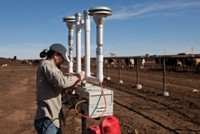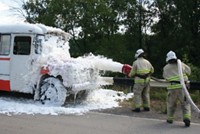Advertisement
Grab your lab coat. Let's get started
Welcome!
Welcome!
Create an account below to get 6 C&EN articles per month, receive newsletters and more - all free.
It seems this is your first time logging in online. Please enter the following information to continue.
As an ACS member you automatically get access to this site. All we need is few more details to create your reading experience.
Not you? Sign in with a different account.
Not you? Sign in with a different account.
ERROR 1
ERROR 1
ERROR 2
ERROR 2
ERROR 2
ERROR 2
ERROR 2
Password and Confirm password must match.
If you have an ACS member number, please enter it here so we can link this account to your membership. (optional)
ERROR 2
ACS values your privacy. By submitting your information, you are gaining access to C&EN and subscribing to our weekly newsletter. We use the information you provide to make your reading experience better, and we will never sell your data to third party members.
Environment
Hunting For Perfluorochemicals In Ski Wax
Toxic Substances: Professional ski waxers may metabolize wax fumes into harmful chemical
by Rebecca Renner
September 20, 2010

In ski racing, the difference between first and second place can depend on hundredths of a second, so racers grab every advantage they can. Unfortunately, the ski waxes that help athletes shave down their times also expose the people who wax their skis to possibly harmful perfluorochemicals. Now Swedish researchers report that the waxers' bodies may metabolize one common perfluorochemical into perfluorooctanoic acid (PFOA), which has been linked to adverse health effects (Environ. Sci. Technol., DOI: 10.1021/es101951t).
During racing seasons, professional ski waxers spend long days working together in small, usually poorly ventilated wax huts melting, scraping, and layering wax onto skis as smoke, fumes, and dust fill the air.
Earlier this year environmental scientist Helene Nilsson of Ôrebro University in Sweden and colleagues reported that PFOA levels are about 50-times greater in the waxers' blood than that of the general population (Environ. Sci. Technol., 2010, 44, 2150).
Other studies have linked elevated levels of PFOA to numerous health effects, including high cholesterol, reproductive difficulties, and thyroid effects. So Nilsson and colleagues set out to determine the exact source of the ski waxers' exposure.
To track down the PFOA source, they followed eight ski wax technicians from the Swedish and U.S. national cross country ski teams during four 2007–2008 World Cup competitions. In the teams' wax cabins, the researchers collected air and particulate samples using portable air pumps fitted with resin cartridges designed to absorb perfluorochemicals.
When the scientists analyzed the samples with tandem mass spectrometry, they detected some PFOA, but the levels were not large enough to account for the waxers' high blood concentrations.
However, they did find that the cabins accumulated a significant amount of 8:2 fluorotelomer alcohol (8:2 FTOH), which has been shown to metabolize into PFOA in rat studies. On a daily basis, the waxers probably breathe in 800-times more 8:2 FTOH than PFOA, the researchers report. So Nilsson and her team concluded that the source of the ski waxers' elevated PFOA levels was the 8:2 FTOH that they constantly inhaled as they worked.
The scientists do not yet know where the 8:2 FTOH comes from: “We don't know if they are actually in the waxes or if they form during the heating process," says Nilsson. The team has planned more studies to find out.
The study is impressive, says environmental chemist Jonathan Martin at the University of Alberta in Canada, but he thinks that the study hasn't completely pinned down the PFOA source, because other components in the gasses and fumes may also metabolize into PFOA.
Still the team's work has already brought about some changes, Nilsson says: Swedish and Norwegian cross country teams have started providing trucks with ventilation and fume hoods for ski waxers.





Join the conversation
Contact the reporter
Submit a Letter to the Editor for publication
Engage with us on Twitter